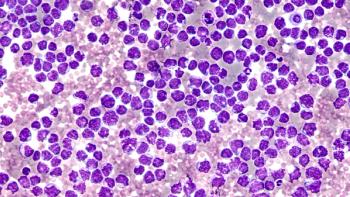
Study Finds miR-543 Could Be a Novel Biomarker for Patients With Myelofibrosis
A study published in JCI Insight determined miR-543, an RNA gene, plays a significant role in the epigenetic landscape of myelofibrosis, specifically via its targeting of the dioxygenases ten-eleven translocation 1 and 2.
A
Ruxolitinib, a JAK1/2 tyrosine inhibitor, is the only FDA-approved therapy for MF, and works by significantly improving splenomegaly (enlargement of the spleen), a main characteristic of advanced MF. However, the treatment does not eliminate bone marrow fibrosis, the most prominent pathological feature of the disease, and some patients with MF are resistant tothe drug.
To understand the underlying cause of resistance and to explore potential treatment routes, researchers compared noncoding RNA profiles of patients with MF who responded to ruxolitinib therapy to nonresponders. They found that miR-543 was significantly upregulated in those who did not respond to ruxolitinib treatment.
By generating differential micro RNA (miRNA) profiles, the researchers concluded their “results demonstrate that increased levels of miR-543 correlate with ruxolitinib treatment ‘resistance’ in patients with MF by promoting genes related to ruxolitinib metabolism and by directly targeting TET1 and TET2 transcripts.”
To reach this conclusion, reverse transcription-quantitative polymerase chain reaction (PCR) was performed in the patients treated with ruxolitinib, in 2 additional independent cohorts in the United States and Romania of patients with MF, and in a JAK2V617F mouse model of MF. In vitro and in vivo models were used to determine the basic molecular mechanism of miR-543 in the disease.
“Our findings suggest miR-543 as a potentially novel biomarker for the prognosis of MF patients with a high risk of treatment resistance and as a potentially new target for the development of new treatment options,” the authors said.
They carried out a phase 1-2 study, evaluating 107 patients with MF who were treated with ruxolitinib. The patients were split into 2 groups “according to whether they had complete elimination of palpable splenomegaly (‘responders’) or had less than 25% reduction in spleen size (‘nonresponders’).”
In addition to determining miR-543 targets epigenetic regulators TET1and TET2, the investigators also identified that “activation of STAT3 by the phosphorylation of JAK2 influences miR-543 transcription through its direct binding to miR-543 promoter.”
The study yielded the following additional results:
- Genome-wide expression profiles of specific miRNAs stratify patients with MF according to their responsiveness to ruxolitinib treatment
- miRNAs between patients with MF who responded or did not respond to ruxolitinib treatment were differently expressed ○ miR-543 and miR-382 were significantly overexpressed and miR-96, miR-182, and miR-183 were significantly decreased in non-responders when compared with treatment responders
- Lower connectivity of the miRNA network is present in responders to ruxolitinib
- miR-543 is overexpressed in MF samples from independent cohorts of patients
- miR-543 markedly delayed the formation and growth of 3D multicellular tumor spheroids in K562 cells
- miR-543 levels are increased by ruxolitinib and by JAKV617F mutation
The researchers urge that future studies be carried out to further develop RNA-based therapeutics for patients with MF.
Reference
Fuentes-Mattei E, Bayraktar R, Manshouri T, et al. miR-543 regulates the epigenetic landscape of myelofibrosis by targeting TET1 and TET2. JCI Insight. 2020;5(1). doi: 10.1172/jci.insight.121781.
Newsletter
Stay ahead of policy, cost, and value—subscribe to AJMC for expert insights at the intersection of clinical care and health economics.













































